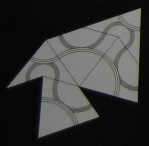Custom-Designed Jigsaw Puzzles
As I've described elsewhere, I've taken to creating personalized puzzles for my young niece and nephew on their birthdays and at Christmas. The first puzzle I designed for my niece was for her fourth birthday. Of course, I tried to take it easy on her: no multi-stage complications, no difficult mechanical gyrations, and no Japanese logic grids. It was just a simple little 36-piece jigsaw puzzle of a photograph showing her and her brother smiling together. (As those of you who are parents already know, 36 pieces is too many for a four-year-old, but she had fun anyway, putting it together with the help of the rest of her family.)
Making that first jigsaw, though, made a lasting impression on me: I really enjoyed laying out all of the piece boundaries, trying to break up (or avoid breaking up) color regions, and looking for a clean, balanced distribution of cuts. Later that year, when I made another jigsaw for her brother for Christmas (that later inspired my puzzle Trail and Error), I got another jolt of that jigsaw-making magic sauce, and then I was well and truly hooked.
With several more jigsaws under my belt, I'm now ready to take the next step: offering to make a custom jigsaw puzzle just for you!
My jigsaws are laser-etched and laser-cut from heavy, 3/16" acrylic, giving them a sturdy, high-quality construction that means they'll stand up to lots of handling and remain crisp and clean for many, many years. Because they're etched, not printed, the design absolutely won't rub off or fade. It also means, though, that I can't do full-color imagery; the acrylic sheet will be one color and the etched areas will be whitened more or less based on the intensity of the laser. What that means, essentially, is that I can reproduce black-and-white photographs, line art, woodcuts, and other such monochrome designs. The highest contrast comes from using black acrylic, but many other bright colors can work well, too.
I can vary the number and the size of the pieces to your taste, from as few as a dozen pieces, say for a young child, up to a few hundred pieces, if you're looking for something more epic. Similarly, the difficulty of the puzzle is up to you: if you like, I can turn out a really nasty set of cuts and an irregular outside edge that should satisfy the most demanding of solvers, or I can give you a pleasant half hour of solving with a few friends. It's up to you!
One of my favorite things to design into a jigsaw is 'specials', pieces in representational shapes that either reflect the subject matter of the imagery or refer to the personality or history of the intended recipient. For example, as seen to the right, in a puzzle celebrating the release of Rachel Hartman's novel Seraphina, I included several musical instruments (reflecting a major theme of the book), Rachel's initials (traced from her own calligraphy on an earlier book cover), and the profiles of two characters from a comic book that Rachel had produced many years earlier. The specials can be whatever shapes you like, whatever it takes to make your custom puzzle truly 'special' to you!
Of course, the cost of a custom puzzle like this is going to vary a lot, depending on just what you're asking me to produce, but here are a few starting points to give you a sense of things:
- about 20 large pieces, including the letters of your child's name in a contrasting color, about 11 inches square, where the design is a simple maze of birthday balloons spelling out "Happy Birthday": $75
- about 40 pieces, 11 inches square, black and white photograph or other monochrome design provided by you, no 'special' pieces: $75
- same puzzle with four custom 'special' pieces: $115
- about 100 pieces, 11 by 18 inches, eight 'special' pieces: $200
- same puzzle, with about 200 pieces and 12 'special' pieces: $350
In all cases, these prices are for the first copy. If you'd like multiple copies of exactly the same design, the additional copies would be $30 to $60 each, depending on the size and number of pieces.
Does this sound intriguing to you? Wouldn't this make a great birthday or holiday present, or maybe a unique promotional item for your business? Please get in touch with me at pavel@pavelspuzzles.com and let's start talking about how I can make a very special puzzle, just for you!

